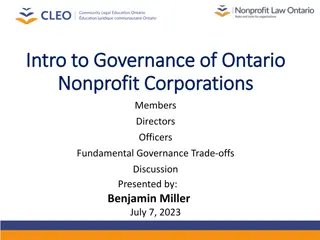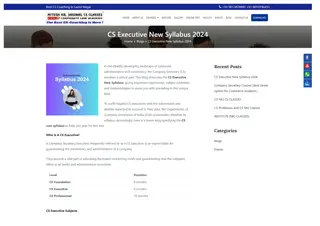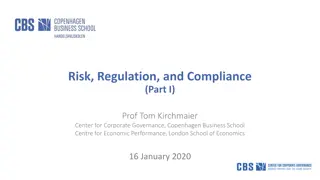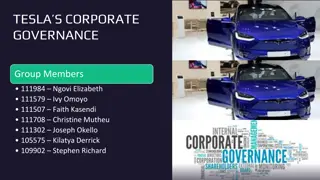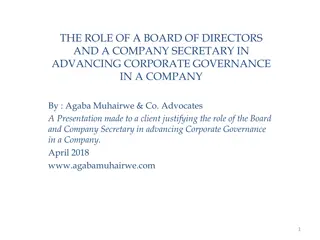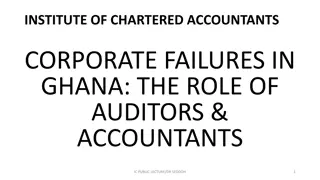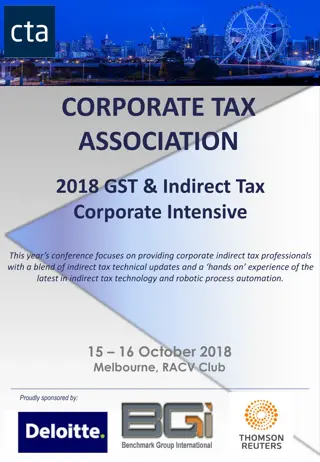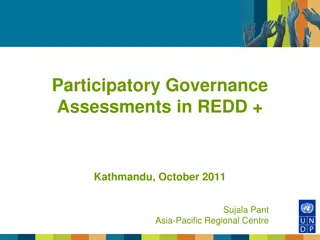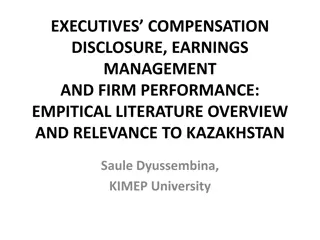Corporate Governance: Key Concepts and Models
Corporate governance explores mechanisms guiding company control and direction, addressing information asymmetry and agency problems. The shareholder model emphasizes conflicts between owners and managers, while the stakeholder model advocates balancing interests for long-term value creation. Diverse corporate governance codes aim to enhance accountability and address short-termism in various jurisdictions, including the Netherlands and the UK.
Download Presentation

Please find below an Image/Link to download the presentation.
The content on the website is provided AS IS for your information and personal use only. It may not be sold, licensed, or shared on other websites without obtaining consent from the author.If you encounter any issues during the download, it is possible that the publisher has removed the file from their server.
You are allowed to download the files provided on this website for personal or commercial use, subject to the condition that they are used lawfully. All files are the property of their respective owners.
The content on the website is provided AS IS for your information and personal use only. It may not be sold, licensed, or shared on other websites without obtaining consent from the author.
E N D
Presentation Transcript
CORPORATE FINANCE FOR LONG-TERM VALUE Chapter 3: Corporate Governance
Part 1: Why corporate finance for long-term value? Chapter 3: Corporate Governance
The BIG Picture 3 Current corporate finance maximises financial value from financial shareholder perspective, ignoring social and environmental externalities Single objective facilitates accountability in corporate governance Solution Expand company objective from FV to IV (= FV + SV + EV) Include current and future generations as stakeholders, alongside shareholders Broaden board diversity and expertise to deal with expanded objective Accountability: single integrated value measure facilitates accountability Incentives: include social and environmental KPIs in performance pay
Core problems in corporate governance 4 Corporate governance refers to the mechanisms, relations and processes by which a company is controlled and directed At the core of corporate governance there are two problems: Information asymmetry between principals and agents Agency problem: agents may not act in interest of principals
Shareholder model 5 Agency theory focuses on conflicts between owners (shareholders) as principals and managers as agents Accountability of managers and the scope for correction (removal of management) Managers might be incentivised to focus on short-term profits Common law countries (i.e., US, UK, Canada): dispersed shareholders & active trading in stock markets Civil law countries (i.e., Europe, Asia): controlling shareholders, less active market for corporate control and management is held less accountable
Stakeholder model 6 Stakeholder model argues that managers should balance the interests of all stakeholders, including financial agents (shareholders and debtholders) and social agents (employees, consumers, suppliers) System of co-determination: both shareholders and employees can appoint representatives to a company s board Corporate governance codes define best practices in corporate governance Codes have started to address the narrow shareholder perspective and short-termism In NL and UK, codes include long-term value creation for stakeholders as a corporate objective
Governance and company value 7 Well-run companies are better able to realise their long-term value potential by making better (investment) decisions Strong correlation between company-level governance and the broad institutional setting of a country Corporate scandals reveal classical agency problems in companies across the world: Americas: Collapse of Enron in 2001 Asia: Olympus-scandal in 2011 Europe: Volkswagen-scandal in 2015
Comparing corporate governance models 8 Dimension Shareholder model Stakeholder model Integrated model Shareholder value Stakeholder value Integrated value Objective Optimisation ?? ??? = ?? + ?? ?? = ?? + ?? + ?? Shareholders Current stakeholders Current and future stakeholders Stakeholders Multiple objectives requires balancing rules for decision- making and accountability Environmental value considerations come second, if considered at all Simple decision-making and accountability Social and environmental value considerations come second, if considered at all Multiple objectives requires balancing rules for decision- making and accountability All values considered Implications
Objective of the firm 9 Shareholder value (Friedman, 1970; Jensen, 2002) Division of labour: companies -> FV; governments -> SV + EV But two problems externalities happen at level of companies (part of business model) 1. regulation cannot effectively capture all externalities 2. Shareholder welfare (Hart and Zingales, 2017; 2022) Pro-social shareholders (which put weight on welfare of others) to address externalities But also two problems shareholder preferences not representative for stakeholder preferences 1. free-rider problem -> underprovision 2.
Objective of the firm (2) 10 Stakeholder value (Freeman, 1984; Magill, Quinzii and Rochet, 2015) Current stakeholders: financial and social (employees, customers, suppliers) But also two problems multiple objectives -> need for balancing rules 1. future generations (environmental stakeholders) not included 2. Integrated value (Schoenmaker and Schramade, 2019; 2023) Inclusion of all stakeholders: current and future But also problem multiple objectives -> need for balancing rules 1. Solution: integrated value as objective IV = FV + SV + EV
How can interests be balanced? 11 Directors should act according to the company s purpose (Mayer, 2018; 2021) By making corporate values explicit, management becomes accountable to deliver on corporate purpose Edmans (2020) argues that value is only created when the social benefits exceed the social opportunity costs Three interrelated principles to deliver value to stakeholders: Multiplication: do social benefits exceed private costs? Comparative advantage: does the company deliver more value than other companies? Materiality: are the benefitted stakeholders material to the company?
Integrated measure for societal value 12 Basic model for integrated value (IV): ?? = ?? + ? ?? + ? ?? FV = financial value SV = social value EV = environmental value b = weighting of social value c = weighting of environmental value (FV is weighted at 1) Allows for a structured balancing of stakeholder interests Board should set parameters (b and c) in advance and in dialogue with stakeholders Current regime is characterised by a very small weighting of social and environmental value (b = c = 0.1)
Organisational forms of companies 13 Public company Main corporate vehicle (especially in UK and US) Private Company Financed by debt and/or private equity Gaining in importance due to fewer agency problems Governmental organisation (state-owned or government intervention) Public objective Efficiency problems due to lacking profit motive
Organisational forms of companies (2) 14 B corporation Number of certified B corps 5,000 Company certified as meeting social and environmental 4,000 standards 3,000 Social enterprise 2,000 1,000 Non-profit with focus on societal impact - 2008 2009 2010 2011 2012 2013 2014 2015 2016 2017 2018 2019 2020 2021 Cooperation / Cooperative Created by groups of people (customers, suppliers, employees) working together for common benefit instead of profit
Role of institutional investors 15 Institutional investors are financial institutions that manage investments for clients Investment funds, pension funds, insurance companies, etc. Growing role: from 67% of GDP in 1990 to 230% of GDP in 2016 250 Two choices for action to influence investee companies: 200 Assets as a % of GDP Voice (or direct intervention): engage with management or 150 vote at AGMs 100 Exit (or divest): (threaten to) leave 50 Rise of passive investments limits impact of voice or exit 0 1990 1995 2000 2005 2010 2016
Managing stakeholders' interests 16 How to include the interests of the various stakeholders in board decision-making? EU is most advanced in including interest of current and future stakeholders in legislation EU Sustainable Finance strategy: 1. Strengthening sustainability disclosure 2. Taxonomy of green investments 3. Clarifying investors duties regarding sustainability 4. Fostering sustainable corporate governance
Sustainability disclosure & taxonomy 17 EU s Corporate Sustainability Reporting Directive (CSRD), effective 2025 Requires companies to disclose information on S and E issues Helps stakeholders evaluate the sustainability performance of companies Encourages these companies to develop a responsible approach to business EU Green Taxonomy Classification system that establishes a list of environmentally sustainable economic activities Creates security for investors, protects investors from greenwashing and helps companies to plan its transition Expansion to (1) cover gray and brown investments (detrimental to sustainability); and (2) include social activities
Board mechanisms at company level 18 Formal stakeholder models: Focus on particular stakeholder 1. Formal stakeholder models interests Board mandates for sustainability: Makes sustainability an 2. Board mandates for sustainability explicit board priority Board composition and expertise: Representative and 3. Board composition and expertise diverse boards are more sensitive to company s societal impact 4. Stakeholder council Stakeholder council: A council that discusses the sustainability performance of the company 5. Incentive mechanisms Incentive mechanisms: Executive compensation can include social and environmental KPIs to make management accountable for sustainability performance
Future design 19 Developed in Japanese local politics, future design aims to solve the dilemma between current and future stakeholders In stakeholder councils, designated people take on the role of future generations People who become members of an imaginary future generation truly change their lines of thought and points of view, becoming clearly aware of the interests of future generations Very important to get voice of young/future generation in boards
Conclusions 20 Corporate governance is about controlling and directing the company Shareholder model: financial value maximisation Stakeholder model: includes current stakeholders Integrated model: includes current and future stakeholders The balancing of the interests of various stakeholders is central to corporate governance Integrated value can provide guidance on dealing with trade-offs between the interests of various stakeholders
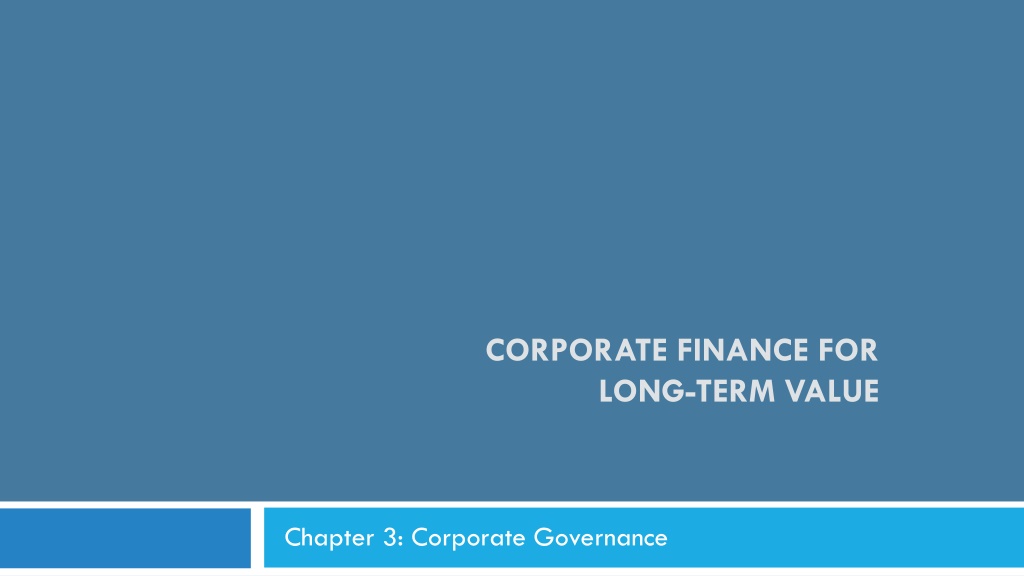
 undefined
undefined



